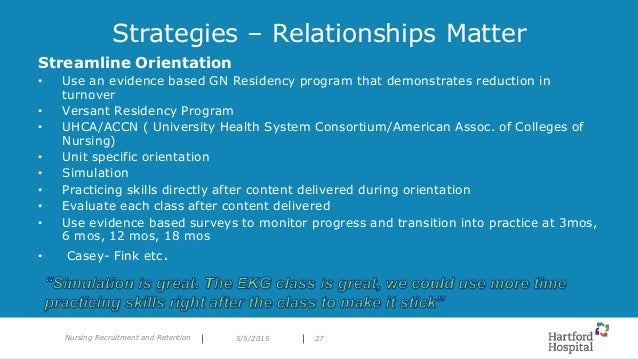Versant Nurse Residency Program Cost

March / April 2007 RN Residency: Seeking a New Paradigm Throughout the program, RN residents are guided by experienced preceptors who teach skills, share knowledge, ensure patient safety, and enhance the quality of care. Image courtesy of Northridge Hospital Medical Center By Judith Sumner BSN, PHN, RN, and Pat Cornett, EdD, MS, RN Few, if any, hospitals have been able to sidestep the many challenges arising from the continued shortage of qualified nurses across the United States. From the large sign-on bonuses many hospitals opt to pay new nurse hires, to the constant use of temporary and registry nurses to balance shifts, the shortage has had a daunting impact on the financial health of the institutions. However, the most important consideration stemming from the crisis in nurse staffing lies in the quality of care that we deliver to patients and, in turn, the level of patient safety that hospitals strive to attain. One need only look at the University of Pennsylvania’s 2002 (Aiken, et al.) study results, which confirm that larger patient-to-RN ratios are directly linked to a greater risk of complications after surgery, to understand the magnitude of this challenge.
One of the key drivers for the rapid turnover that contributes to the nursing shortage is the “preparedness gap.” While hospitals aim to address patient safety by ensuring there are sufficient RNs for every shift, the reality is that new graduate RNs may not be sufficiently prepared to assume the complex RN role in acute care. For instance, many nurse training programs have limited clinical immersion components. As a result, new graduate RNs receive fewer opportunities to learn the skills, techniques, protocols, and best practices of their hospital. Compounding the lack of hands-on practical experience is the fact that fewer new nurse graduates have the opportunity to work shoulder-to-shoulder with veteran nurses. It’s hardly a surprise that U.S.
Hospitals lose anywhere between 35 to 60 percent of their new nurse workforce within 12 to 24 months (Jones, 2004). Unlike graduate medical education, which is partially funded through Medicare and standardized according to different disciplines under the purview of the Accreditation Council for Graduate Medical Education, there are no structured nursing residency programs with nationally accepted standards. Comprehensive residencies are not yet required.
Dudley Perkins A Lil Light Zip Sweatshirt. Although the Versant program costs about $5,000 per resident, the cost is well worth the benefit, according to Krozek. “Hospitals get 100% return on the investment because of the difference in turnover rates,” he says. “Hospitals will need to hire fewer new nurses.”. With the exception of the Versant Residency Program, which varies in length, all of the nurse residency programs in the included studies lasted one year, which is the minimum length of time in an acute setting that new graduate nurses identified as necessary to be comfortable and confident in their new roles (Casey et al.,. Cornell Versator Manual. We would like to show you a description here but the site won’t allow us.

Difference Between Positivism And Interpretivism Pdf Files. Furthermore, there is no overarching organization to ensure that quality standards are met. Consequently, there is tremendous variance across hospitals nationwide. As such, there is little guarantee that the homegrown residencies, internships, or in-house orientation programs adequately prepare new graduate nurses to deliver adequate patient care and clinical services. More than ever before, our profession needs comprehensive, structured training and focused retention efforts to increase the confidence and competence of nursing graduates, reduce churn, lower costs, and, most important, ensure higher levels of patient safety. Evidence-Based Training Driven by Consistent Clinical Standards Northridge Hospital Medical Center in Northridge, California Image courtesy of Northridge Hospital Medical Center Northridge Hospital Medical Center in Northridge, Calif., is a 411-bed facility that boasts some of the most technologically advanced and compassionate services — from the Neuroscience Institute, Level II Trauma Center, and heliport, to cancer care and a Women’s Health Center. Yet, even with its commitment to delivering quality care, not even Northridge was immune to the burdens arising from inadequate RN staffing.
Accordingly, Northridge assembled a modest training program of 6 to 8 weeks for medical/surgical nurses (somewhat longer for certain other specialties) that consisted of classroom activity and preceptorship on the nursing units. However, as valuable as these previous efforts were, they did fall short of the larger emerging goal: ensuring a higher level of confidence and competency through carefully tracked, evidence-based training and consistent clinical standards and practices. In 2004, Northridge embarked on an ambitious initiative to transform its nurse training program by implementing the Versant RN Residency. The residency, an evidence-based, outcome-driven, comprehensive 18-to-22-week program, encompasses more than 600 hours of precepted clinical time and 200 hours of classes. The residency also features mentorship and peer-support components. All participating new nurse hires at Northridge maintained their full-time paid employee status throughout the duration of the residency.